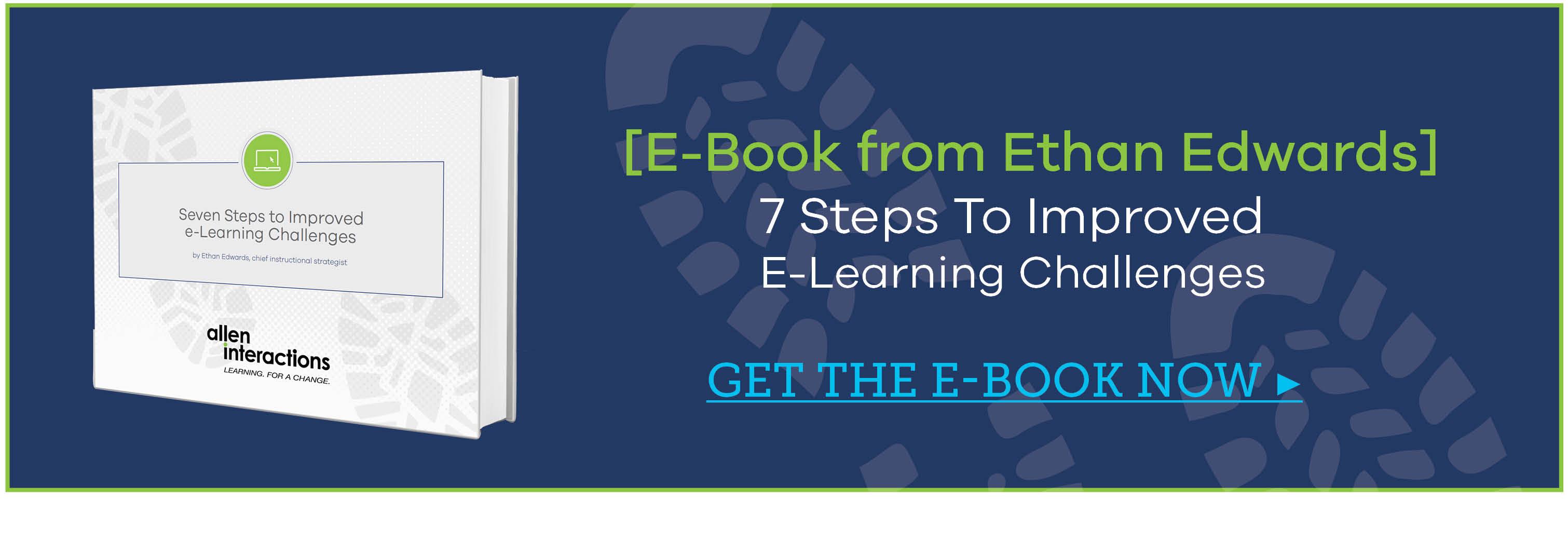Blog
Stop Scaring Your Learners: 4 Ways to Bring Life to Boring e-Learning ...
By Hannah Hunter, Instructional Writer Does this sound familiar? You’ve spent weeks writing, editing, and re-writing e-learning content only to watch ...


5 Scientifically-Proven Ways to Grab Attention in Your e-Learning
By Hannah Hunter | November 12, 2015 | Custom Learning | 0 Comments
By Hannah Hunter, Instructional Writer
.png?width=125&name=Hannah(250).png) Does this sound familiar? You’ve spent weeks writing, editing, and re-writing e-learning content only to watch learners skip through your carefully constructed on-screen text as fast as their little fingers can click “Next.” As demoralizing as this experience can be for a designer, it is not new to any of us. In our office, we even have a saying: “You can lead a learner to content but you can’t make him read.”
Does this sound familiar? You’ve spent weeks writing, editing, and re-writing e-learning content only to watch learners skip through your carefully constructed on-screen text as fast as their little fingers can click “Next.” As demoralizing as this experience can be for a designer, it is not new to any of us. In our office, we even have a saying: “You can lead a learner to content but you can’t make him read.”
Nielsen eye-tracking studies have demonstrated that web users, on average, read only about 28% of words on screen at any given time. And, might I add, that’s how much attention the average reader gives to articles they’ve personally selected because they are, presumably, interested in them. Try not to think about how that number applies to last year’s mandatory compliance training.
Instead, let’s concentrate on doing everything we can as writers and designers to make those 28 out of 100 words count!
On-screen text can be a powerful tool to motivate, inspire, entertain, and educate. And, instructional designers can use many tools to help make on-screen text Meaningful, Memorable, and Motivational.
Here are five science-backed writing tips to grab your learners’ attention and keep it:

1. Implement CCAF across all of your content, not just the interactive parts
Each sentence in your e-learning course should have a benefit to the learner that outweighs the time it would take to read through it. A great way to do this is to use the buckets of the CCAF Design Model to organize your textual content: Context, Challenge, Activity, and Feedback.
Ideally, the bulk of the learning in your course will be imparted as part of an interactive, performance based challenge. The rest of your content should be used to support your interactions by developing the context, instructing learners on how to complete the activity, setting up the challenge, or imparting feedback based on the choices that the learner makes. Feedback is my favorite place to integrate important pieces of text, as the value to learners is obvious to them—they want to know how they did and why! Structuring text this way creates a natural scaffolding of concepts that fosters understanding and retention.
2. Cut excess text
The human brain can only retain about seven pieces of information in short term memory at one time. Instructional Designers can help learners remember the important stuff by limiting the amount of information we throw at them.
Excess text is “interesting” but not directly tied to the learner’s performance and takes the focus away from the critical pieces content. Plus, large blocks of text simply look so daunting that some learners don’t even attempt to read them. Do yourself and your learners a favor and, if you can’t CCAF it, cut it or make it an accessible resource they can access if they need or want the additional guidance or information.
3. Create curiosity with your headings
6 secrets of clickbait the experts don’t want you to know. Number 4 will SHOCK you!
Sound familiar? “Clickbait” is the Internet term for luring readers with titles that provide just enough information to make us curious, but not enough to satisfy our curiosity without reading the associated content. It’s the curiosity that’s key. Studies have shown that curiosity is a kind of deprivation that humans are psychologically programed to resolve. Clickbait titles entice us with the promise of some unknown skills or knowledge. Instructional designers can use headings or course titles to tap into curiosity, too. Which would you rather read?

4. Highlight the important stuff with visual cues
Our eyes are trained to search for the novel items on a page that stand out from the rest. Eye-tracking studies have found that we take in visual information in a pretty uniform order: pictures first, then headings, subheadings, bullets, and lastly, paragraph text. Use these facts to your advantage when you design:
- Readers love color: People read more words on a colorful page than a black and white one.
- People spend more time looking at images than text: Utilize your media resources to create visually appealing infographics and/or supporting images.
- Create a visual hierarchy of information: Headings should be big and bold, sub headings slightly less so, and down the line.
- Break up your text: Bullets, short sentences, bolding, and other visual cues draw the eye and enhance memory.
- White space is your friend: A healthy amount of white space improves a reader’s focus on the important stuff.
- Ask an artist for advice: If you have a media team, lean on them. They can give you advice on how to make your text visually appealing.
5. Add a human touch
Humans are social animals; we remember facts best when they are presented to us in a conversational tone. When you write, talk to your learner like you would talk to a friend. You can use techniques like:
- Using the word “you” because it’s personable and builds rapport
- Writing in short sentences and using conjunctions – that’s how people talk
- Telling stories
- Adding humor
- Using relatable analogies to explain complex topics
- Avoiding jargon
- Inviting the learner to take an active role in your story with phrases like “Imagine,” “Consider this,” or “Can you believe?”
There are a multitude of techniques that you can use to make your instructional writing inviting and informative; these are just a few of my favorites. Share your writing best practices in the comments below!
LIKE WHAT YOU'VE READ? CLICK HERE TO SHARE THIS READY-MADE TWEET:
CLICK TO TWEET: 5 Scientifically-Proven Ways to Grab Attention in Your #eLearning http://hubs.ly/H01pmXJ0 #aiblog

About the Author: Hannah Hunter
Hannah Hunter is an instructional writer at Allen Interactions. When she’s not sharing her passion for life-long learning, Hannah enjoys painting, experimenting with new recipes, and volunteering as a creative writing tutor for middle and high school students. She also frequently blogs on Allen Interactions’ e-Learning Leadership Blog.
Comments
Would you like to leave a comment?
Related Blog Posts

By: Hannah Hunter | Oct, 2014
Category: Custom Learning

Blog
Freedom from Wasted Training: The e-Learning Bill of Rights
By Hannah Hunter, Instructional Writer Does this sound familiar? You’ve spent weeks writing, editing, and re-writing e-learning content only to watch ...
By: Hannah Hunter | Jul, 2013
Category: Custom Learning, Strategic Consulting

Blog
5 Tricks to Demolish your Creative Blocks
By Hannah Hunter, Instructional Writer Does this sound familiar? You’ve spent weeks writing, editing, and re-writing e-learning content only to watch ...
By: Hannah Hunter | Mar, 2015
Category: Custom Learning


